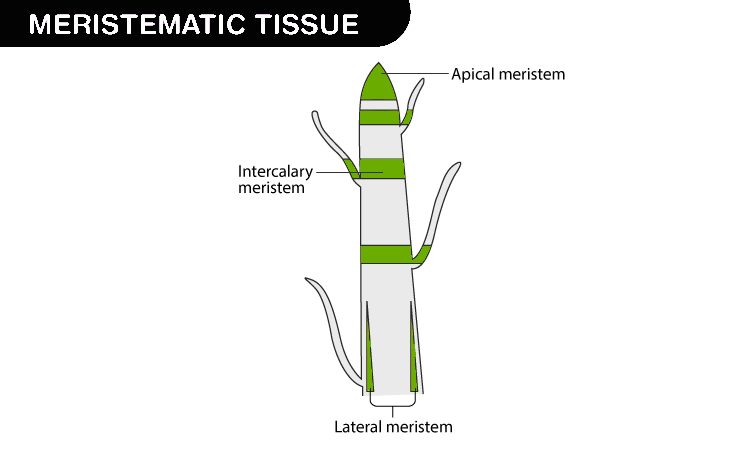
Meristematic Tissue
Oct 14, 2022, 16:45 IST
The term meristem was introduced by Carl Wilhelm von Nägeli. Meristematic tissues have undifferentiated cells forming specialized plant structures' building blocks. Meristematic tissues have living cells of various shapes. They have a large nucleus without a vacuole. Cells have no intercellular space. The place where these cells exist is called the Meristem. Meristematic tissue cells have the ability to actively divide to form specialized structures such as leaf and flower buds, root and shoot tips, etc. These cells help increase the length and bulk of the plant.
| Table of Content |
Definition
"The plant tissue that can divide actively throughout life is defined as Meristematic tissue ."
Characteristics of Meristematic Tissue
The following are the characteristics of Meristematic Tissue:
- The cells of these tissues are called Meristems.
- They have very small and few vacuoles.
- It has a self-renewing quality because each time a cell divides, one cell remains the same as the parent cell and the others form specialized structures.
- The protoplasm of the cells is very dense.
- Meristematic tissue heals the wound of an injured plant.
- These cells do not store food.
- The meristematic tissues are living and thin-walled.
- They exhibit a very high metabolic activity.
- They have a single, large and distinct nucleus.
Types of Meristematic Tissue
Meristematic tissue has the following types:
On the Basis of Origin
Promeristem
- It originates from the embryo.
- It is the youngest and earliest meristematic tissue.
- It is generally found in the root and the shoot tips.
- The primary meristem arises from the promeristem.
Primary Meristem
- Cells divide actively.
- It arises from the promeristem.
- It is present a little below the promeristem and forms the permanent tissue.
Secondary Meristem
- The permanent tissue forms from the secondary meristem.
- It originates from the primary meristem.
On the Basis of Position

Apical Meristem
- Apical Meristem is present at the tips of roots and shoots and helps in increasing the height of plants.
- Different cell divisions facilitate cell growth in roots and shoots and help enlarge cells.
- The apical Meristem has two parts the promeristem zone, which contains actively dividing cells, and thus the meristematic zone, which includes the procambium, ground meristem, and protoderm.
Intercalary Meristem
- These also help to increase the length of the internode.
- It is located within the internodes and leaves at the intercalary position.
- It is also a part of the apical Meristem and adds to the plant's peak.
- It is in a neighborhood with monocots, grass, and pines.
Lateral Meristem
- It is located in the roots and stems on the lateral side.
- It also increases the Plant thickness.
- Cork and vascular cambium are the two lateral meristems.
- These divide pre-clinically or radially, leading to a rise in permanent secondary tissues.
On the Basis of Function
Protoderm
- It also protects the plants from any mechanical shocks.
- It is the tissue of outer plant and forms the epidermis.
Procambium
- It is the innermost tissue and also leads in the rise to the xylem and phloem.
- It helps transport water and nutrients to different parts of the plant.
Ground Meristem
- The cells is large with thick walls.
- It also forms the cortex, pericycle, and pith.
- The meristematic tissue is usually found within the apices of the root systems, and thus the shoots are in a continuous state of division.
Frequently Asked Question (FAQs)
Q1. Define Meristematic Tissue.
Ans. A plant tissue that has the ability to divide itself actively throughout life is called a Meristematic Tissue.
Q2. Who discovered Meristematic Tissue?
Ans. The term meristem was coined by Carl Wilhelm von Nägeli.
Q3. Can meristematic tissues divide?
Ans. The meristematic tissues, or simply meristems, are that tissues in which the cells remain young and can divide actively throughout the plant's life.
Q4. Where are meristems found?
Ans. Meristems are regions of unspecialized cells in plants capable of cell division. Meristems produce unspecialized cells that have the potential to become any specialized cell. They are found only in certain parts of the plant, such as the tips of roots and shoots and between the xylem and phloem.
Q5. What type of cell is found in meristems?
Ans. Undifferentiated cells
Q6. Why are meristematic cells small in size?
Ans. Plant cells become large in size when they contain a large central vacuole. Meristematic cells are metabolically active and undergo active cell divisions. They do not perform the task of storage and therefore do not contain large central vacuole.







